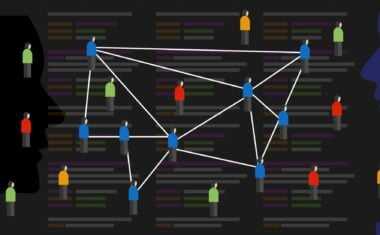Amazon Data Scientist Interview: A Complete Guide

In this article
Data science roles at Amazon are highly competitive and difficult to land. Fortunately, enough people have successfully gone through the Amazon data scientist interview process to share their experiences and offer valuable advice.
If you’ve graduated from a data science degree or bootcamp, put together an impressive portfolio, polished your programming and quantitative analytics skills, and have scored a coveted interview with an Amazon recruiter or hiring manager, you might understandably be nervous about what comes next.
Interviewing for any role can be an intimidating experience, but the best way to ensure success is to be prepared for what you’ll be asked and to know what the company is looking for. Current and former Amazon data scientists share their own interviewing experiences below. Read on to learn more about what it’s like to interview for a data science role at Amazon.
What does a data scientist at Amazon do?
Data scientists at Amazon fall into four broad categories, each allowing them to specialize and apply their analytical skills to different product and service areas.
- Data analytics
Data scientists who specialize in this area typically have a focus on business intelligence. This role requires them to create dashboards, forecast trends, devise strategic solutions to business challenges, and present data-backed findings to leadership and other stakeholders inside the company in an accessible way. As a customer-centric company that’s driven by data, being able to wrangle and input large amounts of data to forecast how people will shop and use its platforms and services is a top concern for Amazon.
- Machine learning
Machine learning specialists at Amazon usually require a Ph.D. or graduate qualifications in deep learning, natural language processing, or computer vision. Data and research scientists in this role are on the cutting edge of research and assist the company in developing new algorithmic models that power Amazon’s Alexa, its streaming services, Amazon Web Services, and other parts of the business.
- General data science
Amazon hires many data science generalists to write optimization algorithms, build experiments with AB testing, run algorithms and models to find actionable insights, and make meaningful recommendations and offer feedback to leadership based on their findings.
- Data engineering
Data analysts in this area are focused on building out data pipelines. Their work often overlaps with that of machine learning engineers.
What skills does a data scientist at Amazon require?
In addition to being proficient in programming languages such as SQL and Python and understanding statistics, Amazon expects its data scientists—whether they’re generalists or machine learning specialists— to be experienced with the full data science pipeline, such as defining a problem, data cleaning, developing a model, evaluating it, and analyzing the findings.
Aashish Jain, a Springboard alumnus who started at Amazon as a data scientist before advancing to the role of a research scientist, said that even though he spends most of his time reading the latest research and developing algorithmic models, he still finds himself using those foundational data science skills in his day-to-day work.
“I mainly work with building different machine learning models, and that involves reading papers, finding out which algorithm works based on my problem, and implementing it using Python,” Jain said. “But it’s not just model building—it’s evaluating. There’s data analysis and data cleaning. It’s the whole data science pipeline.”
It’s not enough to simply be technically proficient, though, according to current and former Amazon employees. The company has a list of fourteen leadership principles that it expects its employees to strive toward, some of which include: customer obsession, think big, dive deep, and deliver results.
In practice, this translates to skills such as having the ability to focus and pay attention to detail, being able to meet deadlines, knowing what kinds of questions need to be asked and answered, and approaching projects with the company’s mission and ambitions in mind.
Get To Know Other Data Science Students
Jonathan King
Sr. Healthcare Analyst at IBM
Sunil Ayyappan
Senior Technical Program Manager (AI) at LinkedIn
Leoman Momoh
Senior Data Engineer at Enterprise Products
What is the interview process for a data scientist at Amazon like?
Amazon’s interview process for data scientists involves a series of phone interviews, followed by onsite interviews and technical challenges.
- The phone screener. Similar to the interview process at Google and Facebook, data scientists who have been through Amazon’s interview process describe the first round of phone interviews that judge a candidate’s suitability for the role. Initial rounds include general HR questions about an applicant’s background, experience, and why they want to work for Amazon. There is then a technical screen, during which the applicant will be asked to explain data science concepts to show that they have the foundational technical knowledge to do the job. According to Glassdoor, applicants have in the past been asked questions such as, “Explain p-value,” “Explain bias-variance tradeoff,” “What is the difference between bagging and boosting?” and “Explain Bayes’ Theorem.” Applicants can also expect to solve SQL or Python algorithm coding questions during this stage in the interview process.
- The behavioral questions. During both the phone interview and the more grueling onsite interview—the latter of which involves a loop with around five or six hiring managers, data scientists, and members of leadership—applicants will be asked data science interview questions where they will be expected to demonstrate the Amazon leadership principles. For example, a hiring manager might ask an applicant to discuss former projects, talk about a time they have failed, or explain occasions when they made trade-offs. According to people who have experience with the interview process, these questions are designed to invite the applicant to connect their response to one of Amazon’s leadership principles, so it’s worth crafting a story around each principle to share during the interview.
What happens after the interview process?
Depending on the role an applicant is applying for, the data science interview process at Amazon can involve additional technical challenges, such as solving coding problems on a whiteboard, or answering questions on machine learning and predictive modeling.The nature of the challenges and additional questions are determined by the needs of the hiring team, the responsibilities of the particular data science role, and the candidate’s level of experience.“Different teams have different requirements,” said Jain, who added that hiring managers at Amazon typically assess job seekers based on both prior experience and the ability to demonstrate that they have the foundational skills and mindset to succeed at Amazon.
“They look at how you would work if you were given a problem. They also want to know what you have done in the past because that tells them about your problem-solving skills. They dig into both.”
Since you’re here…
Thinking about a career in data science? Enroll in our Data Science Bootcamp, and we’ll get you hired in 6 months. If you’re just getting started, take a peek at our foundational Data Science Course, and don’t forget to peep our student reviews. The data’s on our side.





